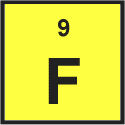Fluorine
|
Fluorine is the first element in the group of halogens which occupies the 17th column of the periodic table. Fluorine atoms have 9 electrons and 9 protons. It is a fairly rare element in the universe, but is the thirteenth most common element in the Earth's crust.
Characteristics and Properties
Fluorine's most notable characteristic is that it is the most reactive of all the elements. This makes it dangerous and difficult to handle. It will react with nearly every other element. It is also the most electronegative of the elements, meaning that it attracts electrons towards itself.
In standard conditions fluorine forms a gas made up of two fluorine atoms called a diatomic gas. It is pale greenish-yellow in color with a pungent odor.
Fluorine is toxic for humans and very corrosive. Many of the reactions with fluorine are sudden and explosive. Fluorine will burn all sorts of compounds and elements including water, copper, gold, and steel.
Where is fluorine found on Earth?
Because it is so reactive, fluorine does not occur as a free element in nature. It is readily found in minerals in the Earth's crust including fluorspar, fluorapatite, and cryolite. The main source of commercial fluorine is fluorspar (which is also called fluorite). The majority of the world's fluorspar is supplied by China and Mexico.
How is fluorine used today?
Fluorine is rarely used in its pure form, but many compounds of fluorine are used by industry.
One of the most popular applications of fluorine is for refrigerant gases. For many years Chlorofluorocarbons (CFCs) were used for freezers and air conditioners. Today they have been banned because they damage the ozone layer. Many of the replacement gases still contain fluorine, however.
Another application is fluoride. Fluoride is a reduced form of fluorine when bonded to another element. Fluoride is helpful in preventing tooth decay and is used in tap water and toothpaste.
Other applications that use fluorine include high temperature plastics such as Teflon, the smelting of iron and metal production, pharmaceuticals, etching glass, and in processing nuclear fuel.
How was it discovered?
Although other chemists had suspected the presence of an unknown element in the compound fluoric acid, it was French chemist Henri Moissan who first successfully isolated the element in 1886.
Where did fluorine get its name?
The name fluorine is derived from the mineral fluorite which comes from the Latin word "fluere" meaning "to flow." The name was suggested by English chemist Sir Humphry Davy.
Isotopes
Fluorine has one stable isotope, fluorine-19. It is the only form that fluorine occurs in naturally.
Interesting Facts about Fluorine
- Hydrofluoric acid is extremely dangerous and can be fatal.
- Henri Moissan was awarded the Nobel Prize in 1906 for his discovery.
- It is found in the gemstone topaz.
- CFCs were once used as propellant in aerosol spray cans.
- The bond formed between carbon and fluorine to make fluorocarbons is the strongest bond in organic chemistry and is very stable.
- Cesium is sometimes called fluorine's opposite element because it is the least electronegative element.

Комментариев нет:
Отправить комментарий